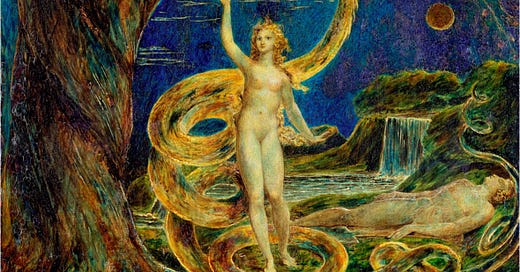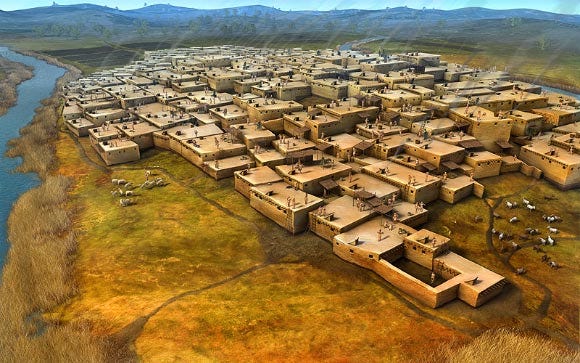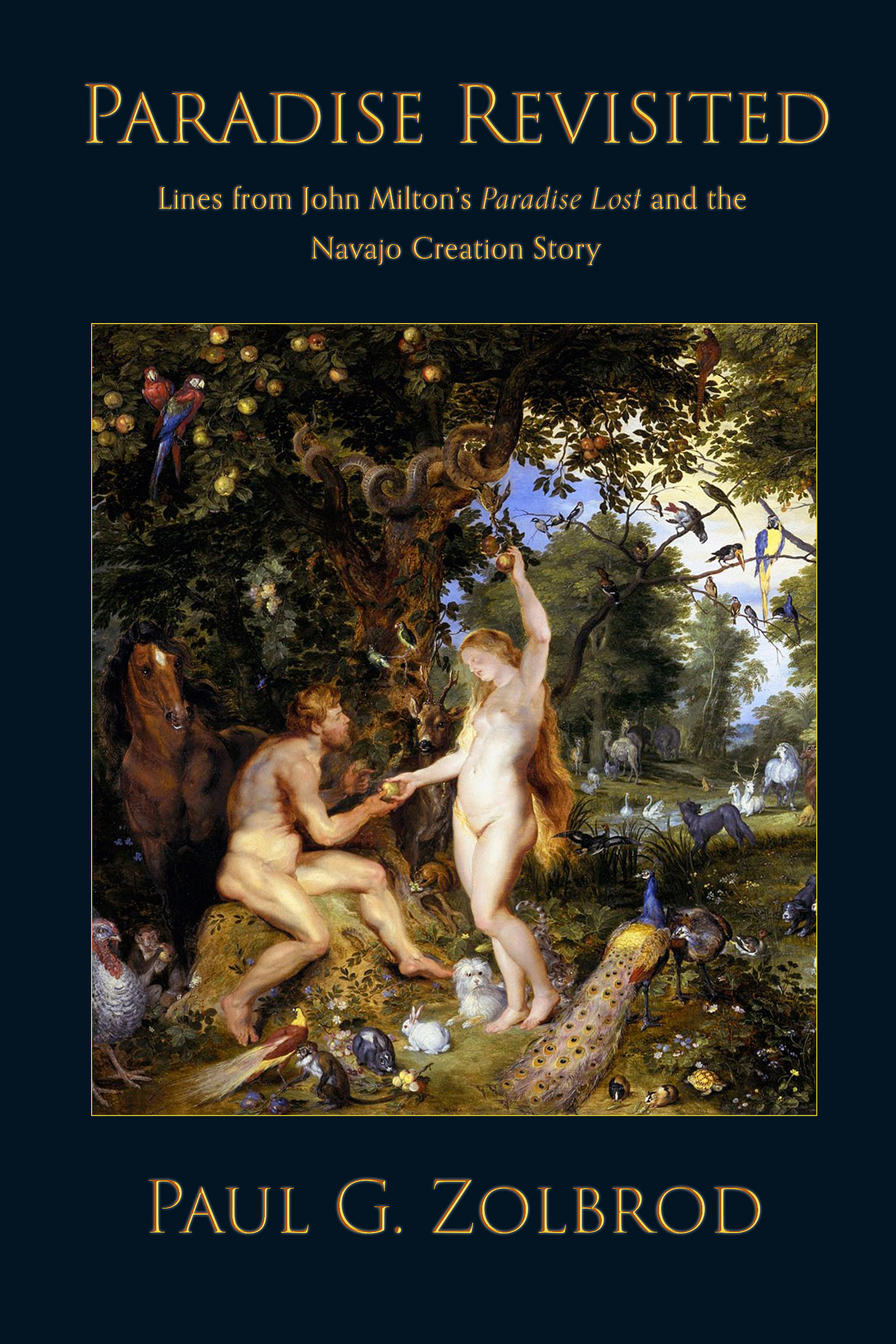Misogyny's Core Myths: The Garden of Eden Story, Part I ...
The Most Dangerous Myth for Women Ever -- Debunked.
Detail of Eve Tempted by the Serpent (1799-1800). William Blake (1757-1827). Tempera and gold on cooper. Courtesy of the Victoria and Albert Museum. Image in the public domain.
© 2024 Morgaan Rhys-Davies Sinclair, Ph.D. All Rights Reserved.
There’s never been a more successful lie than the biblical Garden of Eden creation story. It’s a great yarn—so good, in fact, that John Milton wrote what is arguably the greatest epic in the English language based on this story, but also upon all the strange theology and dogma and virulent execration of women that grew up around it.
There’s a lot of debate about whether Milton was a misogynist himself, was merely a product of his time and upbringing, or was himself a proto-feminist. I come down on the side of proto-feminist, and I’ll tell you why. But first a little real (not fictional) history.
As we wrote before, The Patriarchy is really rather new in terms of its life as a male-privileging tool for social organization. For 300,000 years before that, there was, simply, equalitarianism and equity between men and women. That equality endured ice ages and tectonic upheavals. The last glacial period wiped out a lot of the archaeological evidence of prehistoric cultures, especially in the Northern Hemisphere where ice ages hit hardest. The ice started melting about 23000 BCE, then it got a bit colder, and then, about 11000 BCE it started to warm up for real. One of the first settlements we find after that is a place called Çatalhüyük in what is now Turkey.
Writes WorldHistory.org
Ҫatalhöyük is one of the largest Neolithic settlements ever discovered. Built more than 9000 years ago in modern Konya Plain, central Turkey, it is known in archaeology as a proto-city, a link between the cave-dwellings of prehistoric hunter-gatherers and the early urban constructions. This is where communities began to grow crops and herd animals in preplanned and systematic ways for the first time in history.
The inhabitants of Çatalhöyük formed an egalitarian society. Bone analyses of the buried skeletons in Çatalhöyük indicate equal diets and equal workloads for men and women.
Ҫatalhöyük is likely reflective of the societal organization that went before it for millennia. As is the case in all ancient cultures, its religion features both male and female deities, the generation of which is preceded by the presence of a singularity of consciousness, not a gendered deity. That’s important. There’s not just a male god who commands the creation of things. And there’s not just a Mother Goddess, there’s always a god with her. There’s not just Osiris, there is Isis. There’s Eros and Psyche. There’s Krishna and Radha. There’s not just Spider Woman, there is Spider Man—and he’s NOT the Marvel guy! There is equality. There is balance. There is harmony.
Now, something is going to change, and the change will happen slowly over a 2,500-year period. It’s going to start in the ancient Near East (although it may have separate origins in China and in Mesoamerica). It’s the coming of The Patriarchy.
And nothing will do more for The Patriarchy in the Levant than the specious Garden of Eden story. Three separate scholarly enterprises will, together, crack the code of one of the many fictional stories crafted to elevate men and enslave women.
I. Gerda Lerner’s The Creation of Patriarchy
[The following quotations are from the Publisher’s Preface I wrote for Dr. Paul Zolbrod’s forthcoming book Paradise Revisited: Lines from John Milton’s Paradise Lost and the Navajo Creation Story. It’s coming out March at the latest. Dr. Zolbrod, one of my grad school profs, has written a brilliant mythic comparison of the Garden of Eden story as Milton tells it and the Navajo creation story—by an egalitarian, not patriarchal culture—and the comparison is stunning. The Navajo aren’t about control: they’re about creating and maintaining hozhoon: harmony, balance, and beauty.]
The first thing to notice is that the title doesn’t say “The Coming of Patriarchy” — or “The Emergence of Patriarchy.” It says The Creation of Patriarchy. That’s because The Patriarchy was, start to finish, a deliberate invention.
The first person to crack open the shell of the deliberately occulted knowledge around this myth was a brilliant scholar called Gerda Lerner. Here’s what Lerner found:
Some have postulated that in prehistory there was a Matriarchy that was the mirror-image of the oppressive religio-political machine created by the patriarchal rulers and religious figures. This is not true. The opposite of patriarchy is not male oppression by females: it is equality.
Also, the coming of The Patriarchy, Lerner wrote, was not the result of women’s alleged biological inferiority and closeness to nature—or by their alleged subpar intelligence—or by their alleged congenital moral depravity. Patriarchy was also not an inevitable side effect of settled agriculture or the invention of the plough, as analyses of the artifacts of Çatalhöyük proved.
Rather, The Patriarchy was crafted, intentionally and consciously, beginning in Late Neolithic tribal cultures in the ancient Near East, and it hinged on incest taboo. Whatever we now think this term means, what it originally meant was this:
The prohibition of incest is less a rule prohibiting marriage with the mother, sister or daughter, than a rule obliging the mother, sister, or daughter to be given to others. It is the supreme rule of the gift.
– Claude Lévy-Strauss, The Elementary Structures of Kinship
Relying on incest taboos that disqualified women from mating with close relations, men began to trade women to unrelated tribes as wives to prevent warfare by intermarriage, as assets to pay debts incurred by males, or as chattel to be used as slaves. In return, men received women over whom they could exercise complete control.
Women were the first traded commodity and the first slaves, and their subjugation would become the model upon which all subsequent forms of slavery were fashioned.
[Sinclair, Publisher’s Preface, Paradise Revisited, Paul Zolbrod, Ph.D.]
II. Anna Juhnke, Ph.D. busts the so-called biblical basis of the vilification of Eve.
Anna Kreider Juhnke was a remarkable woman and a brilliant Milton scholar, who taught English at Bethel College for 30 years. She was also, like her husband, a Mennonite. She served twelve terms on the Mennonite Central Committee and chaired it for three.
Anna Junhke wasn’t just a brilliant English professor: she was a brilliant Bible scholar. She would not live long enough to read The Mythology of Eden — up next — but she would be the first to break down the misogyny around the Garden of Eden story, and the execration of Eve and therefore woman from a completely biblical perspective. he was the first to do so, and her wisdom has informed Milton studies ever since.
Again, from my Publisher’s Preface of Paul Zolbrod’s book.
Where there is misogyny in Paradise Lost—and there is—it is not associated with Eve but rather with female entities spawned by, or ruined by, evil angels. Anna K. Juhnke, writing in Milton Quarterly 22.2 explains:
Eve as the seducer and destroyer of Adam, and therefore Woman as the seducer and destroyer of Man—this was one central theme of a two-thousand year literary and artistic tradition of misogyny. In Paradise Lost, however, Milton rejected sexual interpretations of the Fall, and he decisively rejected the misogynistic stereotype in his portrayal of Eve. Diane Kelsey McColley and William Shullenberger have convincingly demonstrated that Milton’s Eve is both free and admirable, living with Adam in loving mutuality.
What Juhnke goes on to explain is that Milton displaced the virulent misogyny developed by Church fathers onto the nonhuman Sin—the incestuous daughter of Satan and mother of Death—and onto the human Daughters of Cain, allegedly so sinful, who were seduced by the corrupt and predatory Watcher Angels. Milton ultimately deflects misogyny away from Eve using the largely nonbiblical sources religious authorities had used to target her to begin with.
For reference, Genesis 3 flatly announces the Fall but offers no comment upon the lapse—or upon Eve. The first indictment of Eve comes not in the Bible, but in the Apocryphal Hebrew Book of Ecclesiasticus or Sirach (c. 280 BCE).
Eve, Juhnke points out, is “hardly mentioned in the New Testament, except in 1 Timothy 2.13-15,” which reads:
For Adam was first formed, then Eve. And Adam was not deceived, but the woman being deceived was in the transgression. Notwithstanding she shall be saved in child bearing, if they continue in faith and charity and holiness with sobriety.
And that’s it. So, of what madness was this Christian misogyny, which would utterly subjugate women and eventually subject them to an Inquisition, made? Writes Juhnke:
On this slight base of canonical Scripture [1 Timothy] was built a Christian tradition that was highly negative toward Eve and all her daughters. Materials were gathered from the Jewish pseudepigrapha, Hesiod’s story of Pandora, dualistic philosophy, and Aristotelian science [sic], as well as from the unconscious dread of women.
Add to these the Apocryphal Book of 1 Enoch, the apocalyptic Book of the Secrets of Enoch, the Testament of Reuben, the ravings of Tertullian, and the paranoid ideations of male ascetics “buttressed philosophically,” as Juhnke puts it, “by a dualism of soul and body, with women representing in a special way the vile, sexual body. Thus also the woman is to be subordinated to the man, as flesh is to spirit.”
When Milton writes Paradise Lost, he includes a profusion of philosophical, pseudoreligious, and Apocryphal theories around the Fall, but he deliberately removes from his characterization of Eve all the blame cast upon her by the mad monks and sexist religious authorities who scoured the world for every shred of religious “revelation” they could find with which to denigrate the feminine, elevate the masculine, and create a patriarchal world in which men controlled everything.
[Sinclair, Publisher’s Preface, Paradise Revisited, Paul Zolbrod, Ph.D.]
STAY TUNED …
Coming soon: Misogyny's Core Myths: The Garden of Eden Story, Part II ... How one specific sect of Canaanite religion pulled off the premeditated murder of the Goddess Asherah — and the brilliant book The Mythology of Eden.
For those of you interested in Paul Zolbrod’s brilliant book (with more than 100 illustrations) go to www.PleiadesBooks.com







Thank you for this I love theology & mythology and how they intertwine. I plan on getting the book.
I do as well! Fascinating! Thank you Dr. Sinclair!